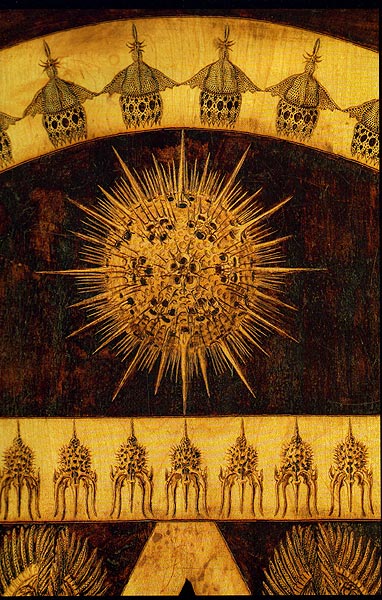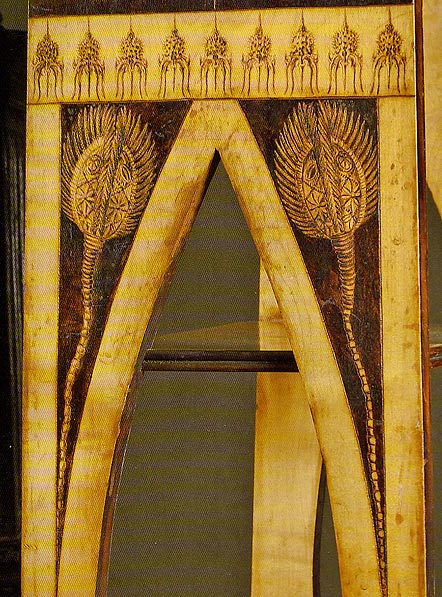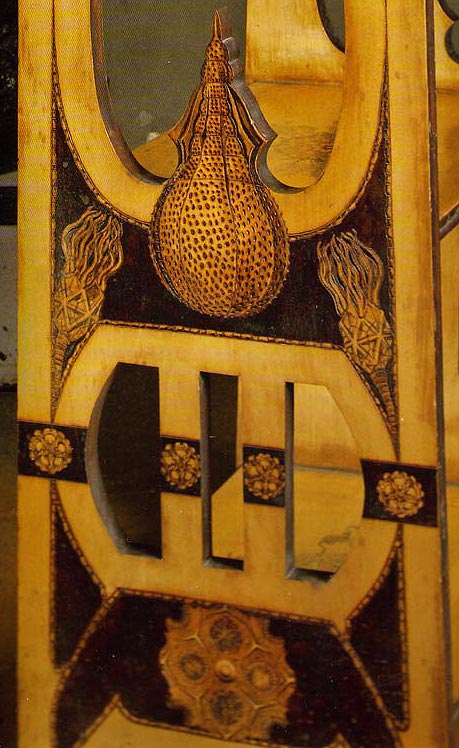E-Museum of Pyrographic ArtAntique Art Hall
|
| - Café Flambé - | - Portraits and Paintings - | - Decorative and Applied Art - |
| - Folk and Traditional Art - | - Antique Art - | - Special Hall - | - Sculpture - |
| - Children's Hall - | - Bookstore and Library - | - Tools and Techniques - |
 |
| Untitled (étagère) By Ernst Haeckel, circa 1880 Pyrography on wood étagère in Villa Medusa, the house of Ernst Haeckel in Jena, Germany Digital image after a photograph courtesy of Ernst-Haeckel-Haus |
 |
| Untitled (étagère), detail By Ernst Haeckel, circa 1880 Pyrography on wood étagère in Villa Medusa, the house of Ernst Haeckel in Jena, Germany Digital image after a photograph courtesy of Ernst-Haeckel-Haus |
 |
| Untitled (étagère), detail By Ernst Haeckel, circa 1880 Pyrography on wood étagère in Villa Medusa, the house of Ernst Haeckel in Jena, Germany Digital image after a photograph courtesy of Ernst-Haeckel-Haus |
 |
| Untitled (étagère), detail By Ernst Haeckel, circa 1880 Pyrography on wood étagère in Villa Medusa, the house of Ernst Haeckel in Jena, Germany Digital image after a photograph courtesy of Ernst-Haeckel-Haus |
Eminent 19th Century German biologist, naturalist, philosopher, physician, professor and artist Ernst Haeckel (1834–1919) when not on expeditions to some of the most exotic places in the world, was professor at the Friedrich Schiller University, and lived and worked from his house known as "Villa Medusa" in Jena, Germany. Today the house, which contains an historic library, is preserved in homage to Ernst Haeckel, and as a museum of his prodigious body of work across many fields.
Books written by Ernst Haeckel are numerous, and his published artworks number over 100 incredibly detailed, beautifully drawn, artistically arranged compositions of flora and fauna of many kinds, especially sea creatures. In addition, his works served as models for the famous collection of botanical glass works done by Leopold and Rudolf Blaschka, glassblowers from Dresden who produced an exclusive collection of glass flowers as well as sea creatures for Harvard University that are displayed in the Harvard Museum in Cambridge, Massachusetts.
An exquisite 302-page coffee table book entitled Visions of Nature: The Art And Science of Ernst Haeckel by Olaf Breidbach, published in 2006 by Prestel tells and illustrates the history, science, and inimitable scientifically accurate art for which Ernst Haeckel is still the world recognized master to this day. Included in the book's front matter, where there are several pages showing the interior of his house, are two excellent photographs of Ernst Haeckel's pyrography étagère.
As of this writing, this work in pyrography is the only one found and there is no known date or signature. According to Dr. Thomas Bach of Ernst-Haeckel-Haus in Jena, "Haeckel got this étagère as a gift...it is unsigned...[and] there are no additional works by him in the house." Yet because of the distinct style of drawing executed in the pyrography, it seems almost surely the work of the one and only Ernst Haeckel. Likewise, because of its superb quality, it is only logical to conclude that this is not the random work of someone trying out the technique of pyrography on a whim, but rather the work of someone who is well versed in pyrography as well as drawing. We can only hope to discover more works by Ernst Haeckel in the pyrographic technique. On the other hand, if this étagère is the work of an artist other than Ernst Haeckel, at the very least, the designs are most assuredly his. The digital images shown here do not do justice to the detail, warmth and tonal beauty of the work.
We hold out the hope of finding more documentation and additional pyrographic works by this artist thanks to the words of St. John's University Director Dr. Maura Flannery in her book Jellyfish on the Ceiling and Deer in the Den: The Biology of Interior Decoration Volume 38, Number 3, The MIT Press: Cambridge, Massachusetts, June 2005, pp. 239–244:
"The 19th-century German biologist Ernst Haeckel is probably best remembered today for his illustrated work Art Forms in Nature [1], which is still in print. Haeckel, who was an accomplished artist as well as a scientist, intended this as a sourcebook of ideas for artists. Some of the most memorable images are those of jellyfish, or medusae. This is in part because these organisms were the objects of Haeckel's own research. In fact, he was so taken with them that he took a leaf out of his own book and used its images as sources for decoration in his home. He had cups and saucers and ceiling designs featuring jellyfish as well as several pieces of furniture with burnt-wood images of medusae."
If you have either any questions to ask or any information to offer regarding this or any pyrographic works by Ernst Haeckel, please e-mail the E-Museum Curator.
You are leaving the
Ernst Haeckel Salon
You can return to the
Antique Hall
or visit one of the following:
Pyrographic Art Exhibit Halls:
Portraits and Paintings
Decorative and Applied Art
Sculpture
Traditional and Folk Art
Children's Pyrographic Art
Special Pyrographic Art
The Book Store and E-Museum Library
Pyrography Tools and Techniques
Your questions and comments are welcome and appreciated.
Please e-mail the E-Museum Curator
Back to E-Museum Entrance homepage
© 2008, 2009 Kathleen M. Garvey Menéndez, all rights reserved
26 September 2008. Last updated 4 November 2009.

